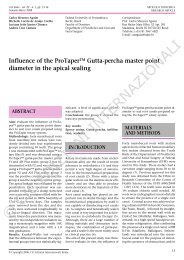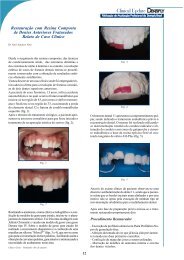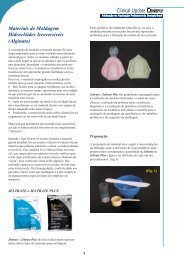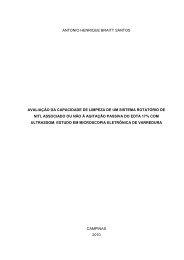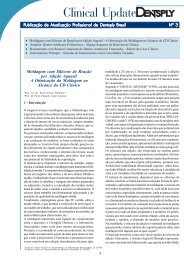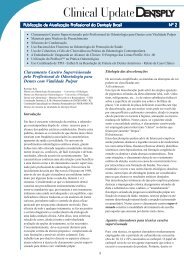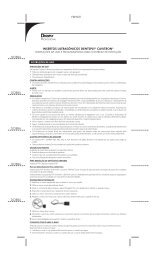You also want an ePaper? Increase the reach of your titles
YUMPU automatically turns print PDFs into web optimized ePapers that Google loves.
Dental Adhesives …. How it All Started and Later Evolved<br />
Karl-Johan M. Söderholm a<br />
Abstract: This article describes how dental adhesives evolved from the cements developed by the Mayan Indians into<br />
today’s modern dental adhesives. Particular attention is paid to Oskar Hagger, a chemist who worked for DeTrey/Amalgamated<br />
Dental Company, and already in 1949 developed an adhesive product called Sevriton Cavity Seal. That adhesive<br />
was acidic and interacted with the tooth surface on a molecular level. His ground-breaking concept makes him the<br />
true “Father of Modern Dental Adhesives.” Hagger’s concept was soon adopted by other investigators, and different generations<br />
of dental adhesives evolved thereafter. Today, after many years of accepting that the key to the success of dental<br />
adhesives is the micromechanical retention resulting from acid etching of dentin and enamel, we still return to Dr.<br />
Hagger’s original concept that bonding can be achieved via molecular interactions between adhesives and tooth surfaces.<br />
That concept is obvious in the development of newer generations of dentin adhesives. These adhesives, like Sevriton<br />
Cavity Seal, rely on acidic monomers capable of etching and interacting on a molecular level with tooth surfaces in<br />
order to form physical/chemical bonds between the restoration and the tooth. Whether Hagger’s concept will become<br />
the norm in the future is still an open question, but one thing is certain: Hagger’s idea is still very much alive.<br />
Keywords: review, generations, clinical evaluations.<br />
J Adhes Dent 2007; 9: 227-230. Submitted for publication: 15.12.06; accepted for publication: 4.1.07.<br />
a Professor, Department of Dental Biomaterials, College of Dentistry, University<br />
of Florida, Gainesville, FL, USA.<br />
Paper presented at Satellite Symposium on Dental Adhesives, Dublin,<br />
September 13th, 2006.<br />
Reprint requests: Prof. Karl-Johan M. Söderholm, Department of Dental Biomaterials,<br />
College of Dentistry, College of Dentistry, 1600 SW Archer Road,<br />
Gainesville, FL 32610-0446, USA. Tel: +1-352-392-0575, Fax: +1-352-392-7808.<br />
e-mail: ksoderholm@dental.ufl.edu<br />
In 1955, Buonocore published a paper entitled “A simple<br />
method of increasing the adhesion of acrylic filling materials<br />
to enamel surfaces”. 15 That paper is often regarded as<br />
the foundation of adhesive dentistry, and today that paper<br />
is the 17th most cited paper published in the Journal of Dental<br />
Research since March of 1919.<br />
Buonocore’s paper 15 clearly outlined different approaches<br />
to obtain bonding between filling materials and tooth<br />
structure. These approaches included: (a) the development<br />
of new materials which have adhesive properties, (b) modification<br />
of present materials to make them adhesive, (c) the<br />
use of coatings as adhesive interface materials between filling<br />
and tooth, and (d) the alteration of the tooth surface by<br />
chemical treatment to produce a new surface to which present<br />
materials might adhere.<br />
In the 1955 paper, Buonocore focused on the (d) alternative<br />
by targeting enamel bonding. He believed that treatment<br />
of intact enamel surfaces would have only limited application<br />
to the broader problems of restorative dentistry. He<br />
focused on enamel etching because he had found that phosphoric<br />
acid or preparations containing phosphoric acid had<br />
been used to treat metal surfaces in order to obtain better<br />
adhesion of paint and different resin coatings.<br />
Obviously, Buonocore used knowledge from other disciplines<br />
and transferred that knowledge to dentistry. What<br />
Buonocore did not seem to consider was that the Mayan Indians<br />
in pre-Columbian times had used acidic cements to attach<br />
their semi-precious stone inlays. 20 He also forgot to<br />
consider that several acidic cements had been used by dentists<br />
more than a hundred years before he invented acid<br />
etching, 27 and that a common zinc phosphate cement was<br />
a mixture of zinc oxide and phosphoric acid. 37 It was well<br />
known that during setting, these cements remained<br />
acidic. 40 What Buonocore forgot was that these cements<br />
were also able to etch tooth surfaces and increase the surface<br />
roughness. During setting, formed setting compounds<br />
grew into the surface roughnesses created by the acidic cement.<br />
Because of mechanical interlocking between tooth,<br />
cement, and crown, retention of the cemented restoration<br />
could be achieved. Considering that the Maya were the first<br />
to use acidic cements, a legitimate question is whether<br />
Buonocore really was the one who invented acid etching or<br />
if that honor shouldn’t go to the Maya. Buonocore’s true contribution<br />
was that he opened our eyes to make us aware of<br />
Vol 9, Supplement 2, 2007 227



